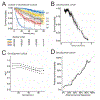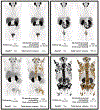A Prognostic Risk Score for Prostate Cancer Based on PSMA PET-derived Organ-specific Tumor Volumes
- PMID: 37070991
- PMCID: PMC10838189
- DOI: 10.1148/radiol.222010
A Prognostic Risk Score for Prostate Cancer Based on PSMA PET-derived Organ-specific Tumor Volumes
Abstract
Background Prostate-specific membrane antigen (PSMA) PET has high specificity in localizing primary tumors and metastases in patients with prostate cancer, but the individual overall survival probability is still difficult to estimate. Purpose To develop a prognostic risk score using PSMA PET-derived organ-specific total tumor volumes for predicting overall survival in patients with prostate cancer. Materials and Methods Men with prostate cancer who underwent PSMA PET/CT from January 2014 to December 2018 were evaluated retrospectively. All patients from center A were split into training (80%) and internal validation (20%) cohorts. Randomly selected patients from center B were used for external validation. Organ-specific tumor volumes were automatically quantified from PSMA PET scans by a neural network. A prognostic score was selected using multivariable Cox regression guided by the Akaike information criterion (AIC). The final prognostic risk score fitted on the training set was applied to both validation cohorts. Results A total of 1348 men (mean age, 70 years ± 8 [SD]) were included, with 918 patients in the training cohort, 230 in the internal validation cohort, and 200 in the external validation cohort. The median follow-up time was 55.7 months (IQR, 46.7-65.1 months; >4 years; 429 deaths occurred). A body weight-adjusted prognostic risk score integrating total, bone, and visceral tumor volumes obtained high C index values in the internal (0.82) and external (0.74) validation cohorts, as well as in patients with castration-resistant (0.75) and hormone-sensitive (0.68) disease. The fit of the statistical model for the prognostic score was improved compared with a model containing total tumor volume only (AIC, 3324 vs 3351; likelihood ratio test, P < .001). Calibration plots ascertained good model fit. Conclusion The newly developed risk score that included prostate-specific membrane antigen PET-derived organ-specific tumor volumes had good model fit for predicting overall survival in both internal and external validation cohorts. Published under a CC BY 4.0 license. Supplemental material is available for this article. See also the editorial by Civelek in this issue.
Figures





Comment in
-
Reawakening of Nuclear Medicine through Molecular Imaging: Quantitative Theranostics and PSMA PET.Radiology. 2023 May;307(4):e230627. doi: 10.1148/radiol.230627. Epub 2023 Apr 18. Radiology. 2023. PMID: 37070999 No abstract available.
References
-
- Hofman MS, Lawrentschuk N, Francis RJ, et al. Prostate-specific membrane antigen PET-CT in patients with high-risk prostate cancer before curative-intent surgery or radiotherapy (proPSMA): a prospective, randomised, multicentre study. Lancet. 2020;395(10231):1208–1216. doi: 10.1016/S0140-6736(20)30314-7. - DOI - PubMed
-
- FDA Approves First PSMA-Targeted PET Drug. J Nucl Med. 2021;62(2):11N. - PubMed
Publication types
MeSH terms
Substances
Grants and funding
LinkOut - more resources
Full Text Sources
Medical
Miscellaneous

